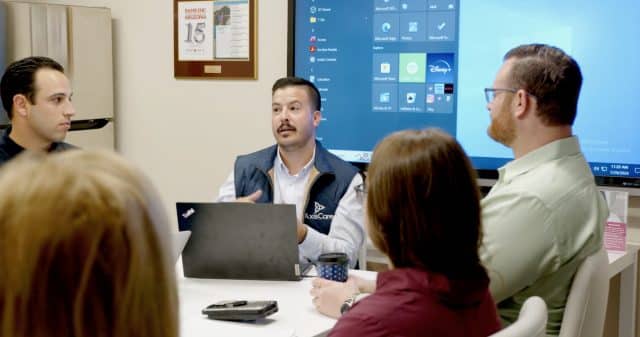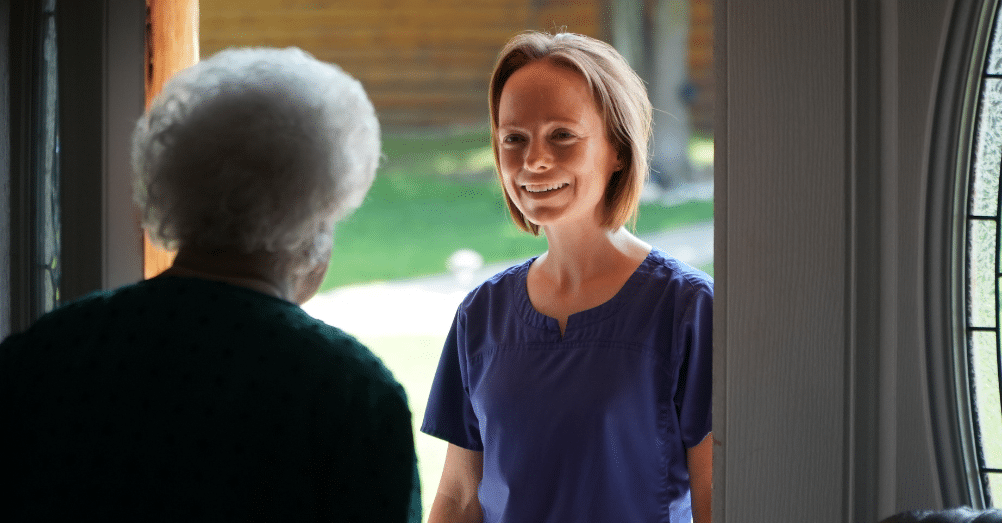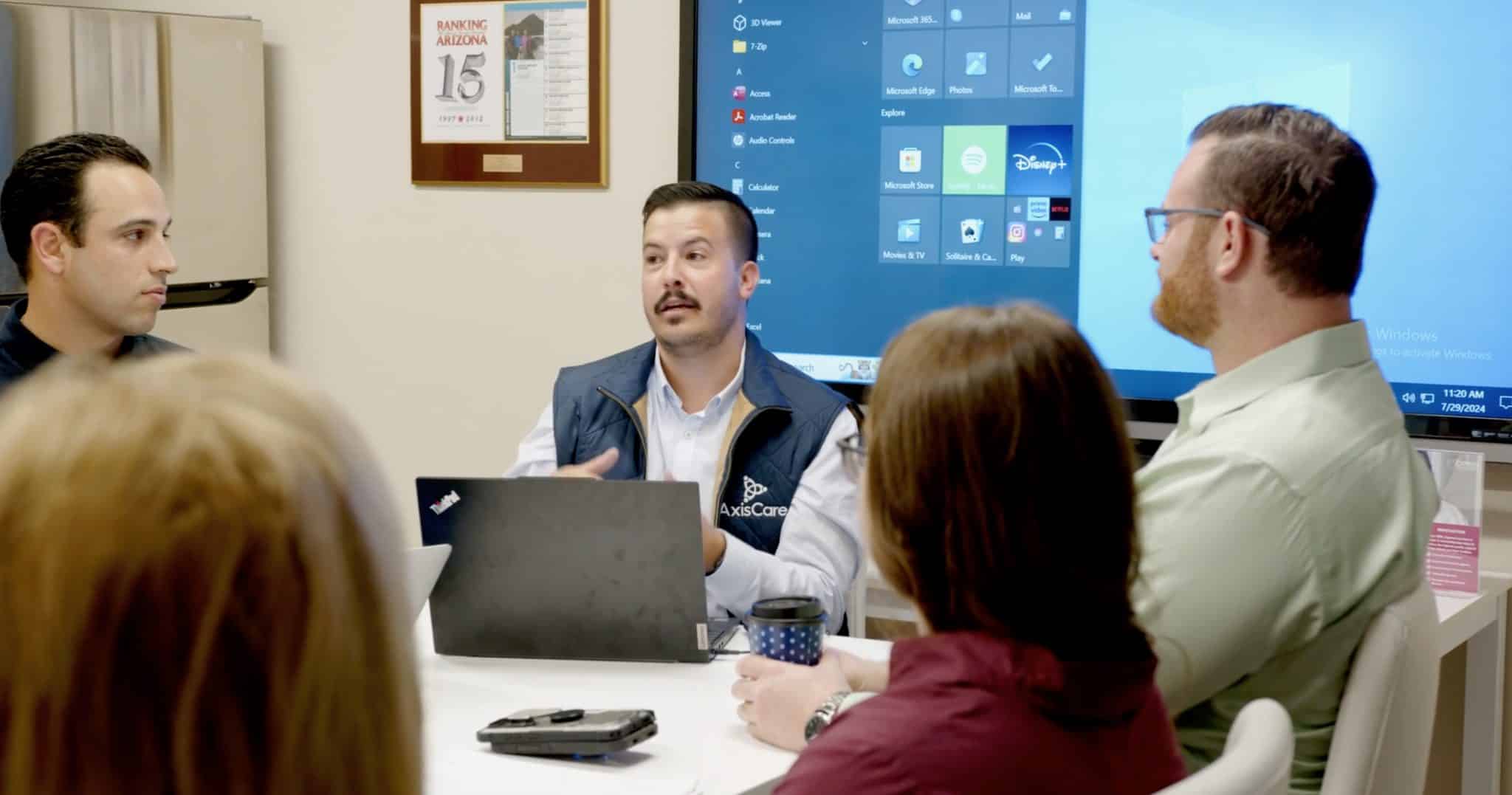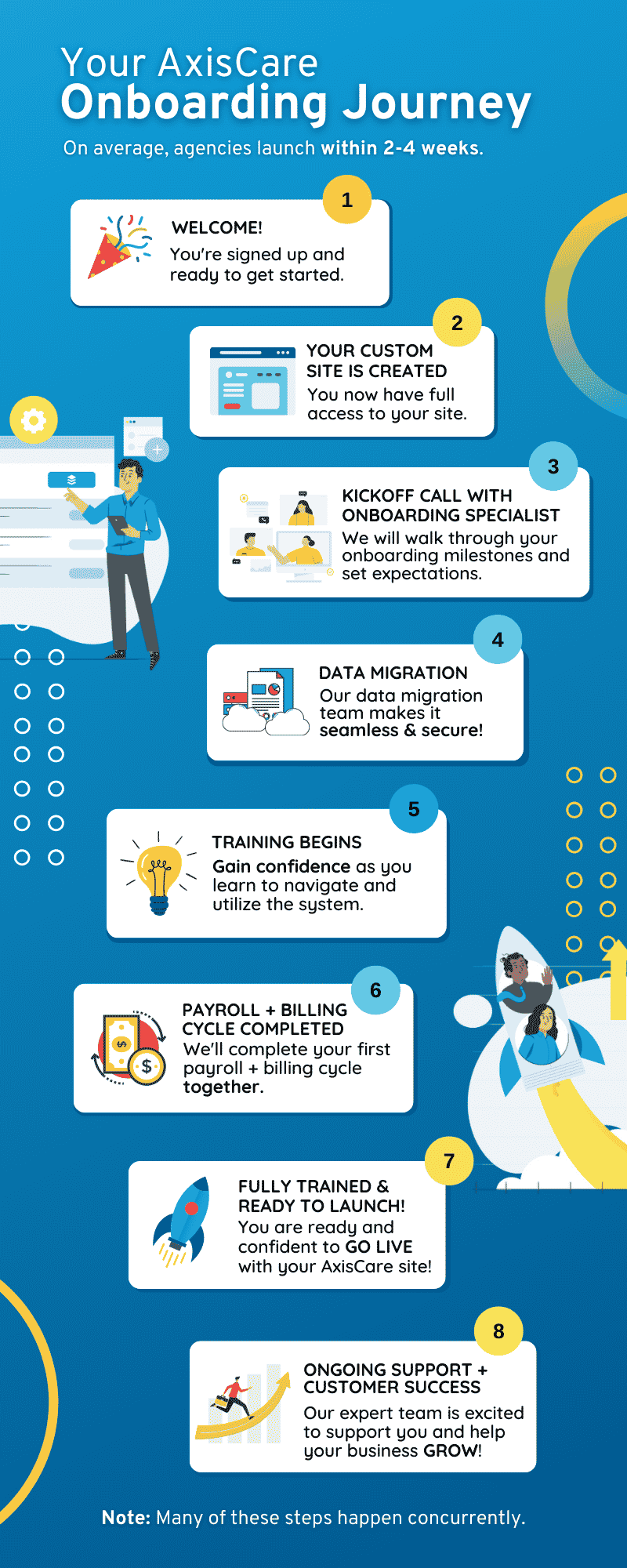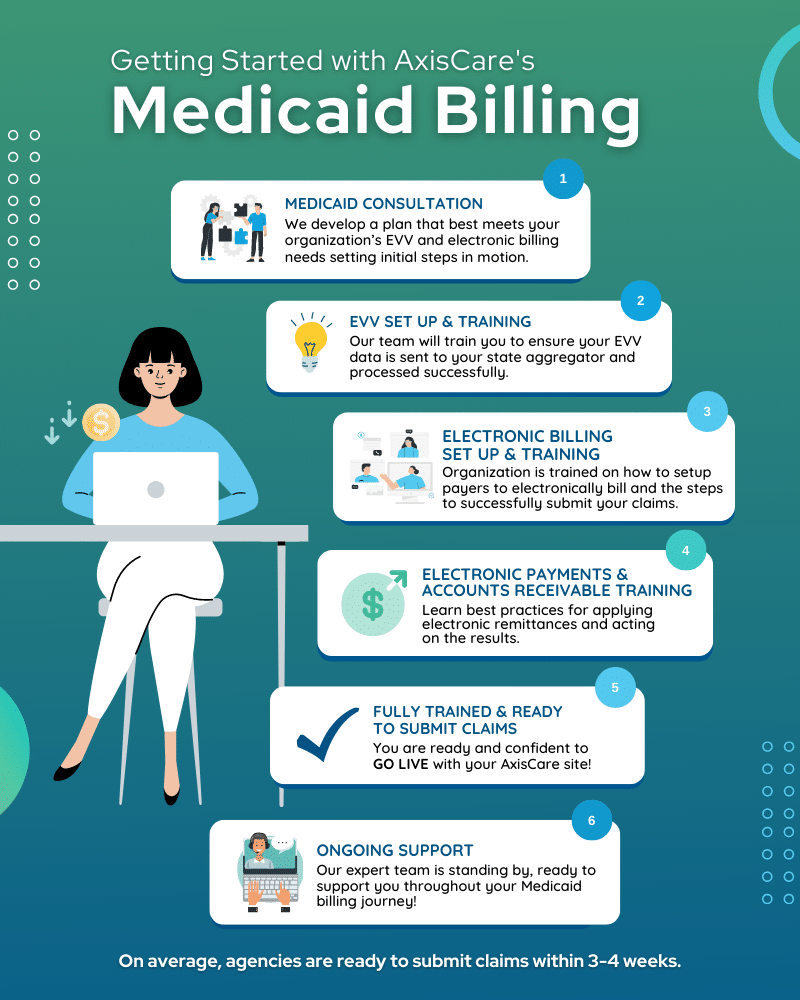Listen in as Todd Allen, CEO of AxisCare and Ari Medoff, CEO of Arosa answer top questions agencies are asking about the current M&A landscape and highlight what executives need to understand about their business to be set up for a future buy/sell.
Miriam Allred (00:08):
Welcome to Vision | The Home Care Leaders Podcast. I’m Miriam Allred with Home Care Pulse. Today, I’ve got Todd Allen, the CEO of AxisCare, and Ari Medoff the CEO of Arosa. Gentlemen, welcome to the show!
Ari Medoff (00:20):
Thanks for having us Miriam.
Todd Allen (00:21):
Thank you.
New Speaker (00:22):
This is a loaded topic, but really there’s no roundabout way to jump into it. So Todd, you work with a lot of organizations around the country on a regular basis to get us started. What’s really been the pulse on mergers and acquisitions high level across the entire industry?
Todd Allen (00:42):
Yeah, well right now I would say it’s, it’s very vibrant. You know, a lot of buyers are looking at the resiliency of the industry in general from last year. You know, with COVID obviously it affected so many industries negatively. I, I would venture to say it did affect our industry negatively maybe in April maybe a little bit in may, but it has bounced back with a vengeance and so buyers are really looking at that and, and, and, you know, really happy about that. So they’re they’re really upbeat about it and bullish. And so, yeah, I think right now a lot of people are looking to the future of the industry and they’re seeing how I think facilities, the writing is on the wall that potentially facilities are going to take a hit. And so not only are they our buyers looking at last year, but they’re looking at the years to come and the switch from taking care of folks in their homes versus a facility and, and what the market sentiment is. And basically it is looking really good for home care.
Miriam Allred (01:43):
What an exciting time to be in an industry like this that’s growing so rapidly. We’ve talked a lot about, you know, the spotlight on home care. I just love that visual, this spotlight on our industry and what an exciting time to be a part of it. So, so let’s dive into some questions that agencies are either asking the experts, which today will be you two or even asking themselves. So, so let’s start with you Ari. I want to talk about, you know, you’ve been through a number of mergers and acquisitions. You’ve experienced it firsthand, but what was, you’ve been in the industry for, you know, about a decade now, what was, when was the first time you started thinking about M&As, when do those conversations really start happening within an agency?
Ari Medoff (02:26):
That’s a great question, Miriam. And the first acquisition that I did was straight out of business school in 2012, but then once I was running that company for a couple of years, I’ll never forget. I got a call actually from the VA. We were serving a few clients here from the VA and they called and said that a, this was on April 1st and accompany had notified them that on April 15th, they were shutting down their doors and the VA was scrambling trying to help these clients find a service provider. And and so within two weeks we had struck a deal with the company that was closing to effectively acquire a portion of their business that stands that that two week deal process stands as the fastest one that, that I’ve ever done. But to get to your question around what is the right time to think about selling?
Ari Medoff (03:28):
I think that the right time is when an owner has something very compelling you know, to, to make them want to go down the process of selling the business. And that could be because he or she starts to feel that they are getting burnt out. You know, Todd mentioned the the way that home care has been in the spotlight this past year. You know, I would point out that we’re in a really tough business to operate the, the logistical challenges that come from running a large workforce, the emotional challenges that come from caring for clients and really caring for their families through difficult parts of the aging journey. You know, the, the caregiver shortage is not unique to any one geography and it’s not new. It’s, it’s been ongoing for years and years. And so you know, we, we are in a business that is I think uniquely difficult.
Ari Medoff (04:34):
It takes, takes a huge amount of emotion, emotional strength and problem solving skills, and that can wear on people and, and, and especially owners. And when the average business is a million and a half to $2 million in revenue, that means you don’t have a big team to disperse some of those challenges. And, and so I think that when owners feel like they’ve hit a plateau or are starting to get jaded or burnt out you know, before that goes on too long, I think that’s a great time to think about selling. Sometimes there are external factors you know, be it health-related or financial related that, that also spur individuals to, to want to sell their books
Miriam Allred (05:21):
In the past 14 months, if you’ve ever felt burnt out, you know, you’re not alone. It’s, it’s been a challenging 14 months. And like you’ve said, this industry is challenging regardless of a pandemic or not, but, you know, there’s never really, it’s not too early to start having these conversations and thinking about it because it could creep up on you really at any time. So good response that being said, Todd, let’s talk about some of the ways you should be setting your agency up to prepare to sell. We talk a lot about tracking and just being able to prove the worth of your agency to me about, you know, what are some of the things that agencies should be tracking or doing in the current to set themselves up for a future sell?
Todd Allen (06:05):
Sure. And by the way, I love this question because it’s, it’s not, it’s not for just the people that are selling or wanting to, you know, thinking about selling even. I mean, if, you know, the things that that buyers are looking for are the things that are going to improve any business anyway. Right. So saying so with AxisCare, I can just share an example. You know, we’re not looking to sell our software company anytime soon, but, you know, I will always take a call from someone just to hear kind of what they’re looking for and just to kind of hear, you know, what the market can bear, even though we’re not even in the market. Because I know that those things, if I take that from that conversation, those things are really going to help my business. So hopefully this, that this statement includes a lot more people that like, Oh, I’m not going to sell any time soon, so I can, I can flip out.
Todd Allen (06:52):
But but you know, some of the things that they look forward, there’s basically two buckets, Miriam, and my experience it’s the tangibles and the intangibles, the tangibles are pretty self-explanatory, excuse me, you know, that’s what I call the top three is your revenue, the growth rate and the profit. And those are pretty self-explanatory. And then I would say tier two of the tangibles that kind of gets into things like retention rate. I would even pause and say, you know, retention rate for caregivers at this point, I’d even be more important than the retention rate for clients. And then the third, the third one is closing ratios. And some of the marketing metrics that we have you know, the cost per lead, the cost to acquire customer even the, the customer lifetime value. Many of those things, those benchmarks can be found online and possibly in the benchmarking study.
Todd Allen (07:45):
If I, if I can plug the Home Care Pulse Benchmarking Study there, I know that there’s a lot of those metrics in there that are very handy. The last one in the tangibles is you know, buyers want some diversity. And so if you have, if you’re working with multiple payers that’s going to favor you. So, you know, if you’re billing, private pay, obviously, but Medicaid depending on what state the reimbursement rates could be very very nice and provide you some margin VA and et cetera, there are a lot of different, these are just, this is just subset. You know, hopefully people listeners know that there’s a lot more, but this this covers kind of the broad stroke, and then you’ve got some intangibles. What we have found, we’ve gotten into some really interesting conversations with folks that are, that are looking to sell, not to us, but they’re just looking to sell.
Todd Allen (08:36):
And, you know, some of those folks, they don’t have clean financials. I mean, they, they might be operating above board, but they’re not the house necessarily is not an order from an organization standpoint. So if someone, you know, say looks in their QuickBooks file and just sees all kinds of mess but nothing nefarious, but still it’s messy that could not bode well for an agency looking to exit also having good processes in place. That’s kind of self-explanatory for any business, but but that does include software tools. And this is a little self-serving, but, you know, have having a software like access care in place is really handy because you can provide reports right away to, to the folks that need them during the due diligence phase. Good culture, good leadership. You know, those are some of the things that, that need to be in place.
Todd Allen (09:26):
And also, I think the last two very important things are having a great reputation in the community. That’s going to be a little harder to prove to the buyer during the due diligence, but but they will be looking and they will be you know, asking around in the community what the brand reputation is like. And then lastly is compliance. You know, if you’re selling or if you’re billing to Medicaid or, you know, other, you know, VA and long-term care insurance, they’re going to want to make sure that you have those compliance workflows in place and that that everything is solid for compliance, hopefully that helps.
Miriam Allred (10:02):
Yeah. I love it. That was a really great synopsis. You know, our listeners can pause and re-listen to that whole segment, because it was kind of a loaded couple minutes there, but really good insights. I want to shoot this over to you, Ari. Todd kind of broke down, you know, the tangibles and the intangibles high level, you know, why does an agency need to realize their valuation? And what’s the importance of knowing your company worth?
Ari Medoff (10:26):
Miriam expectations are huge. And, and understanding a little bit about the seller’s perspective is going to help you triangulate onto something that is realistic. You know, it was funny when I set out to buy a business you know, in, in 2011 and 2012, everyone thought that their business was worth $10 million. It didn’t matter if the business, and I’m not just even talking to home care here. It didn’t matter if the business was doing 200,000 in EBITDA or 2 million or 3 million in EBITDA which is, you know, net profit, essentially everyone thought their business was worth $10 million. It seemed to be some magical number, understanding more about how a seller is going to evaluate your business is hugely important. I think that Todd hit on most of the key metrics that we look at, but some others are client diversification, revenue, diversification.
Ari Medoff (11:22):
I would much rather buy a business you know, to take a $2 million agency you know, if they have 10, 24/7 clients and they get one call every three months for a new client, you know, for, from a new prospect, that’s less attractive than a $2 million business that maybe has a mix and maybe they have 30 or 40 or 50 clients and have a healthy pipeline. So, so I think diversification is important and then plug for Home Care Pulse here, a company takes quality assurance seriously is measuring their satisfaction. It is measuring that, that brand awareness and that brand reputation. And so you know, it’s not a deciding factor, you know? Yes or no. But when we think about the types of companies, we want to acquire those that take ‘QA’, quality assurance seriously is certainly helpful.
Todd Allen (12:18):
Oh, I was going to, I was going to add something and you might touch on this. I didn’t realize that you were going to keep going. So I apologize, but I will say too, for buyers that are just going to scratch the surface and do the scratch and sniff test is what I call it. Typically you have an inflated version of what your company is, where and that’s because it’s typically your baby, right? You know, we, we build our companies and we spend a lot of time and effort. And a lot of times it’s our second family. You know, depending on how healthy you are. And so you, you have an inflated version of what you think your company is where then. So I think that’s an important metric for you to know going in listeners, that when you start talking to a buyer, they’re actually going to look at the cost that it’s going to take them to get the company where it needs to be. And that could be to flip it in several more years or to run it for many years. But but typically that is a little bit of a different expectation than what you have.
Ari Medoff (13:11):
The company is worth what a buyer will pay for it. And that is not meant to be flippant answer or trite, but it is a fundamental truth. And so most businesses you, you can look at some public filings, Nova Leap, and Chris Dobbins was a guest on the Home Care Pulse Summit with us. You can look at their public filings and, you know, they’re typically paying three times to four, maybe four and a half times a trailing earnings that is very typical for a small to mid-size agency. In, in, in home care, you know, when it’s a much smaller company, then that’s going to dip below three or three and a half times, if it’s larger, if you get north of 5 or 6 million in revenue, you know, you could creep up above four times that or four and a half times, and maybe you get to five times, but the, the market is limited by by, by who is buying these agencies and these companies, and what they’re able to pay.
Ari Medoff (14:21):
One thing that I think is also important in determining value is that I have come to appreciate as an acquire simplicity is very helpful. I used to think that it was attractive to have different kinds of service lines, and maybe we do some transportation that we build for, maybe we do some you know, some other related business that that, that again has had, you know, pediatric occupational. For example, as a small business line as we have grown I have found that the simpler, the the business, the more focused the business, usually the more successful. And and so I think that would probably be true for most strategic buyers. And we can talk about the different types of buyers later, but you know, what a business is worth is what a, what a buyer will pay for it. And we can talk more about different types of value in a moment if you’d like to Miriam as well.
Miriam Allred (15:24):
Yeah, really good points. I mean, I know we’re going to get to actionable takeaways for our listeners today, but just the things that I’m writing down, diversification, reputation, and simplicity. Those are things that agencies can focus on right now in the present. You know, you don’t have to be ready to sell or looking to sell, but, but reputation, diversification, simplicity. Those are things that they can implement and be working towards right now. So I love, I love those thoughts from both of you. Let’s kind of drill down and talk about the ‘why’ behind a buy and sell. Ari, a company needs to be confident in their ‘why’ from day one, but why is that so important as you continue to grow a business?
Ari Medoff (16:06):
It is important and actually critical to know why you are going down this path of selling because selling is a process. It is a journey. It usually takes 6-9 months from the time that a, a letter of intent is signed, especially if it’s an individual buyer six to nine months is very typical, even though every LOI pretty much says 90 days and you work towards 90 days, but usually it’s longer. And there are going to be bumps in the road. They’re going to be things that the seller finds out about your company that maybe they don’t like, they’re going to be things that you learn about the seller. I’m sorry about the buyer that maybe were a bit different than you thought at the outset, your lawyers are going to get involved. And they’re going to argue about things like indemnification and reps and warranties and these legal terms that most of us had never heard of or thought about before buying a business or selling a business.
Ari Medoff (17:09):
And you have to have a a strong conviction as to why you’re entering this process. Otherwise you will get fatigued, you will get frustrated. And the other thing I would focus on is building a personal relationship between the buyer and the seller, because at the end of the day, lawyers are going to do their thing. And sometimes that is very frustrating or thinking about the worst possible riskiest outcome. And there just has to be a level of trust on a personal level between the buyer and the seller to get through those. And so I, I th I think that, you know, you really do need to look inside yourself as you set out on this process and, and know that that, that it’s not going to be easy and smooth the entire time, but you remind yourself of why you’re, why you know, to get through those tougher times,
Todd Allen (18:12):
Especially in the middle, if I may you know, the landscape kind of looks like two mountain tops at the very beginning and the very end, right? So at the very beginning, you know, you’re super excited and things are looking really good. And, you know, even, you know, the person that you’re talking to might even give you a little inflated valuation at the beginning to start the conversation, and then you have the Valley. And that Valley has to, has everything to do with what our age has mentioned. You know, you need to make sure that, that, that relationship is solid because due diligence and all those numbers, you can just get caught up in the muck and mire of all that. But then in the end, hopefully there’s another mountain top. So that’s, that’s why it is important because depending on how I know we’re going to talk about this later, but depending on what post-sale looks like, you know, if the owner is going to stay on, then it’s really important how you treat that Valley. You know, you could get fed up with numbers and you could get fed up with the process and, you know, burn some relational equity there that you don’t want to do.
Miriam Allred (19:08):
Good example of the mountains, the peaks and the valleys. I love that! Before we talk about the post-sale landscape, you know, we mentioned the types of buyers. Todd, do you want to walk us through what types of buyers are out there right now? What are we seeing?
Todd Allen (19:23):
Sure. Well, again I’ll just mention some, maybe not all of them, but they, they kind of fall into general buckets and I hate to over-generalize, but institutional that’s the private equity, growth, equity even private investors. So even, you know, entrepreneurs who are just looking to get into the market, maybe in your community, or you know, maybe out of Silicon Valley or somewhere else that are looking to just get one business and run it. So that’s kind of institutional, and then there’s more strategic type a type of buyer profile. And that could even be distilled down to even a family member. Right. You know, maybe someone who’s in the business right now, maybe an employee who wants to eventually, you know, come up with a finance plan to take it over for you. I could see that being a very successful way.
Todd Allen (20:13):
Maybe not as they might not be as entrepreneurial as you, or have a big picture. So that’s something that you would need to look at. Like someone like Ari would have the larger agencies they ha they bring a lot more resource to the table. And even like a franchise network, you know, there are some franchises that they’ve hit their limit as far as territories go in the U S so they’re looking to, to get to get more into the independent space and by, by independent agencies. And of course, upstream, you know, you’ve got home health and hospice, and the sniffs that are potentially looking into home care, we’ve seen a little bit of this and then caught wind of you know, hospital networks, even in big healthcare networks, getting into home care, you know, where they just have their, they want to be a part of that care continuum because there’s back and forth, referral source built in there’s a referral source workflow built in.
Todd Allen (21:07):
So it makes sense. That’s that’s pretty much it, but I did also want to mention that, you know, there are, and we talked about this and then chat with the experts a couple of weeks ago in our session, but there are brokers and bankers. They’re definitely things that you want to know before you, you know, you go down that route. But I, I did want to put in a plug and I didn’t tell him this, but Angelo Spinola, who’s probably all the listeners have heard of, but he has been with Littler Mendelson for many, many years and the home care space. He recently changed firms. He’s now at Polsinelli, but even working with someone like him could really help you on the compliance, you know, look under the hood before you start the process so that you can clean up some of those things and he can consult with you because he’s dealt with so many agencies on a compliance level. And now I think he’s getting a little bit more into the to the M&A. So I thought that would throw that out there as well.
Miriam Allred (21:58):
Ari, anyone or anything that you want to add to that?
Ari Medoff (22:01):
Miriam, I’d love to connect that question about the type of buyer to the question around value, because when we say value everyone’s mind goes to dollars, right? Total dollars. That’s what everyone thinks about when you think about value, but it is important to unpack that and realize that there are a bunch of different things that go into value. As you think about a deal. For example, what’s the certainty that a deal’s going to get done. And if you are selling to an individual, maybe it’s a 25 year old, who’s never done a business acquisition before, and they’re having to borrow all the money from a bank for the first time and their credit is shaky. Well, that’s probably not the highest certainty to close. Whereas there might be strategic buyers or others who have done 10 deals or 15 deals in the past.
Ari Medoff (22:57):
You know, and they obviously have a proven track record of getting a deal done speed to close. In some cases, the speed to close is very important to folks because because of any number of different factors structure, deal structure, how much is cash upfront? How much is a seller note or an earn-out? What do the details around that look like? And then for some people, an ongoing opportunity w maybe with the bigger company is very important. I’ll tell you two of our most amazing leaders within Arosa today, our Director of Care Management, Amy O’Rourke she she sold her business, her wonderful business called the Cameron Group to Arosa back in back in 2019 in Orlando, Florida. And now she is helping to run the largest private pay care management business in the country, and, and is a tremendous role model and leader across the company.
Ari Medoff (23:56):
Another’s Angie Landmesser. Her mother was the owner of a great small agency in Grayslake, Illinois called Partners in Senior Care and Angie today is helping to really elaborate and expand our culture of caregiver appreciation. Company-Wide she’s also a systems expert. And so when we have made this transition to AxisCare over the past couple of months she has really been a leader and trainer for, for all of our markets and, and all of our other area directors. And so I think that you know, thinking about what comes after is, is very important for certain sellers and can be part of the value equation.
Miriam Allred (24:41):
Yeah, really good points. Thanks for adding that in tying your, your worth to the buyer, because that is so important to have that, that picture of how they come together and work so perfectly. Let’s talk a little bit about that post sale landscape are you’ve experienced this firsthand, you know, after the acquisition or the merger, you know, after everything is said and done, everything’s not said and done. There’s a whole other chapter of, wow, teams coming together, service lines coming together, financials coming together. It’s, there’s still a lot of work to be done in that post-sale landscape. So just high level, what are a couple of things that an agency should look out for, or maybe be excited for, but, you know, also a couple of, you know, anticipating a couple of bumps down the road, you know, what would you just encourage or, or highlight for an agency owner?
Ari Medoff (25:30):
Most… uh and when I say most I’m talking 99.5% of caregivers and clients experience seamless transitions, if done correctly, you know, really their day to day the care that is being provided that should not be interrupted. And, and again, most buyers who I’ve ever done it before, we’ll be able to pull that off seamlessly office teammates. So you know, your scheduling coordinators recruiters salespeople that they, they would be the ones who would change the way that they’re doing business more frequently. And, and more of their day to day would be impacted whether that is changing the operating system that’s being used, or the accounting system that’s being used, maybe that is changing their job function. You know, that that is a, that is hard for some people. And for some people, it is really exciting. It is exercising a muscle.
Ari Medoff (26:31):
You know, we were talking about running earlier before this podcast started. It is stretching that hamstring that you know, you have not stretched in in years if ever. So some people really rise the occasion and get excited by that new challenge get excited by potentially being part of something bigger than, than what they were were used to before. But but, but I wouldn’t underestimate that that it is that, that it does take a mindset to, to embrace that change. And it can be very small things, for example maybe a company that you bought had a different holiday schedule, right? And, and maybe they didn’t consider president’s day holiday, or for us, we, we make mother’s day a holiday where we build time and a half and we pay time and a half, and most other agencies that, and companies we bought don’t have that.
Ari Medoff (27:25):
So we need to get communication out around that. That’s a very small thing, bigger things are health insurance and benefits. And I can tell you, that’s a very big deal to anyone who is on you know, who’s on a company’s health insurance plan. They always want to know and should know what what kind of plan you know, they’re going to be switching to. So it, you know, there, there are, I kid you not a hundred, well, over a hundred, 200 things that, that we have outlined in our integration plans. You know, and, and we tick through them methodically. And and some of those changes happen day one, some of those changes happen day 30 or day 60, but, but it usually is a you know, it’s a, multi-month sometimes multi quarter integration process. And again, any good buyer should be coming up with that integration plan before deal ever closes and, and hopefully sharing a lot of the key facets of it with, with you as, as a, as a seller.
Miriam Allred (28:27):
Yeah. And as painful as that process may be, I’m sure it’s a great time to restructure, reanalyze, you know, really drill down on every facet of your operations and refine your processes. So, so yeah, appreciate everything that’s been said there on the integration plan.
Ari Medoff (28:42):
Miriam, one other thing that I cannot emphasize strongly enough to any seller who is going through the process, run the business as though you are going to own it for the next 25 years until the day that a deal closes. That means you know, in terms of personnel decisions, in terms of signing a contract for that software, or, you know, signing a lease. That business is your business until the day that it isn’t. And you need to make decisions as though you’re going to run it forever. And I have seen deals get in trouble where owners, you know, start looking ahead and maybe cut a cost here, cut a cost there, or make a decision there you know, to try to boost revenue, but it’s not profitable and wouldn’t be the right thing. That’s gonna, that’s gonna backfire most of the time. And so run the business with the integrity, with the passion, all the energy you can muster until the day that a deal is done, because that is when a buyer is going to expect. And and, and that’s what you need to do for the, for the organization.
Miriam Allred (29:48):
You’re jumping the gun here already, but that’s okay. In closing, I wanted to ask both of you, what is one takeaway from each of you that you’d recommend to providers that they can start implementing in their businesses today, leaving this conversation? We’ll start with you, Todd.
Todd Allen (30:05):
Yeah. That is a really hard question because it’s almost like you have to have the perfect answer, right. One takeaway. I think if they were able to distill down, you know, a lot of owners don’t report to anyone, right. They don’t, they don’t know how, you know, maybe in a, in a former career they did, but they have gotten out of the habit of distilling down very complex and information to, to a very simple reporting kind of mechanism. I would say that that’s what actually I would recommend. I know that’s a little out of the box, but be able to share your metrics that are high level at the drop of a hat. You know, know them have, obviously have the right software, but know how to present in a lot of times as owners, we get a little rusty. And so as a, as kind of like my answer part B would be to maybe get advisors trusted friends or people in the industry that, that, you know, and trust to maybe help with that effort, to be able to report to them, ask their advice, get counsel from them, and then implement
Miriam Allred (31:11):
Ari. What would you add?
Ari Medoff (31:13):
Understand what a buyer’s red flags are going to be. And that could get back to the point I shared earlier about really pushing a seller on the why and understanding that that could be having too much family in the business. You know, if you have four family members, all in key functions, I can tell you buying that business and integrating that business is going to be a challenge. And, and that would be a concern as a buyer, a 1099 versus W2 issues. I think these are going to become heightened. And you know, I got a call just actually last week from a company that really wants to sell, but they have contractors and that’s just not something that you know, that, that we can entertain. And so I shared with the seller that they would need to go through that transition first before we would entertain a process together. And then lastly, don’t wait until you are too tired or jaded. And the business is declining month after month, quarter after quarter. There there’s a phrase catching a falling knife and you know, most buyers are not going to have the appetite for that. And quite frankly, most sellers are going to have a difficult time adjusting their mindset to what the business value is, if it is in decline. So don’t wait too long, make sure you understand why it is that you are wanting to sell.
Miriam Allred (32:45):
Fantastic! Todd and Ari, it has been an insightful 30 minutes. Thank you both for your passion on not only this topic, but really the industry at large. It’s been a pleasure to hear from both of you.
Ari Medoff (32:58):
Miriam, thank you for what y’all are doing on this podcast and appreciate, appreciate your time today.
Miriam Allred (33:08):
Thanks for listening to this episode of Vision. If you want to learn more about this topic, head over to homecarepulse.com/podcast, and check out the recent video of Todd Allen, Ari Medoff, Jeff Weiberg and Chris Dobbin, as they dive deeper into the merger and acquisition landscape on the recent 2021 Home Care Growth Summit. The full conversation is available on this episode’s landing page. Thanks again and we’ll see you next time!



